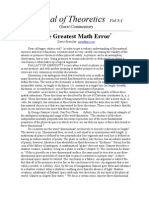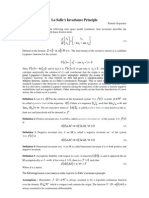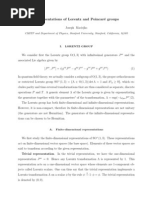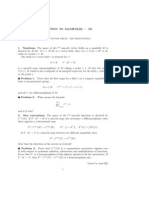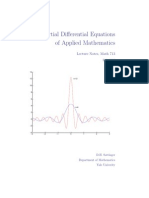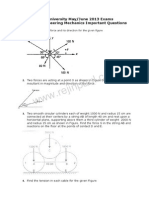Wave Propagation in Even and Odd Dimensional Spaces
Uploaded by
SrinivasaWave Propagation in Even and Odd Dimensional Spaces
Uploaded by
SrinivasaHome Search Collections Journals About Contact us My IOPscience
Wave Propagation in Even and Odd Dimensional Spaces
This content has been downloaded from IOPscience. Please scroll down to see the full text.
1955 Proc. Phys. Soc. A 68 521
(http://iopscience.iop.org/0370-1298/68/6/307)
View the table of contents for this issue, or go to the journal homepage for more
Download details:
IP Address: 152.3.22.62
This content was downloaded on 03/10/2013 at 20:23
Please note that terms and conditions apply.
Wave Propagation in Even and Odd Dimensional Spaces
BY N. L. BALAZS
Department of Physics, University of Alabama
MS.received 26th October 1954 and in amended form 11th January 1955
Abstract. In this note we plan to show how the evenness and oddness of
the spatial dimensions influence the general properties of wave propagation.
The solution of the inhomogeneous wave equation will be given by a multiple
integral; one of the integrations is to be performed in a complex time-plane.
The singularities of the integrand in this plane have an alternating character
depending on the evenness or oddness of the spatial dimensions. If the
space is odd-dimensional, the singularities are poles ; if it is even-dimensional,
the singularities are branch points. This, then, will alter profoundly the
properties of the solution.
0 1. INTRODUCTION
O L ' r E R I I A was the first who clearly recognized the characteristic role
V of the spatial dimensions in wave propagation.
Suppose a short signal is emitted at the origin of a coordinate system
in a space. This signal will be observed at a point having the distance r only
after r / c seconds ( c being the velocity of propagation of the disturbance). This
is true, irrespectively of the number of spatial dimensions. However, if the
space is odd-dimensional, the effect will disappear after a correspondingly short
time. If the space is even-dimensional the effect will not, in general, disappear.
In odd-dimensional spaces short signals, as observed at a point, have a sharp
front and sharp rear ; in even dimensional spaces they still have a sharp front,
but a tail, or diffuse rear.
The mathematical theory of Volterra was generalized by Hadamard (1952) and
Riesz (1936). Their methods are very beautiful, and rather sophisticated.
It is, however, not easy to see why this characteristic difference arises. (For
an excellent review of Volterra's and Hadamard's methods see Courant and
Hilbert 1937).
Our aim here is to show, by a very elementary method, how the evenness
and oddness of the spatial dimensions can give rise to such a profound difference.
0 2. OUTLINE
OF APPROACH
The method we will use is an extension of an idea conceived by Herglotz
(l904) and Sommerfeld (1910).
Imagine a differential equation F ( x , y , ...; U,...)= O . F is an analytic
of all of its arguments, and u(x,y,...)is analytic in x , ~..
, . Then
One can continue F and U in the complex domain conceiving x = x 1 + i x z ,
Y = Y , + i y , etc. as complex variables. As soon as this is done the difference
between hyperbolic and elliptic differential equations disappears, and the
of one type can be used in the construction of the solution of the other
PHYS. SOC. LXVIII, 6-A 35
522 N . L. Baluzs
type. For our purpose a simplification can be introduced: keeping the spaG
variables in the wave equation real and letting only the time variable be compla
Then we are still able to pass at will from the wave equation to the poten&
equation and vice versa ; (the potential equation refers to the same number I
dimensions as the space-time dimensions appearing in the wave equation). For
if the time variable is a pure imaginary we obtain the wave equation ; if it is rq
the potential equation.
Our plan will then be as follows: (i) We construct the solution of t$
n-dimensional inhomogeneous potential equation by the standard metho&
T h e solution will be given in form- of integrals. (ii) W e continue it in th
complex domain introducing a complex x,, (which then corresponds to the tiI$
variable), and obtain in this way the complete solution of the inhomogeneoh
wave equation, also in the form of integrals. When performing the indicati
integration in the complex x , plane we must pay due regard to the singularitit
of the integrand in this plane. (iii) Next we show that the alternating charactr
of the solutions for even and odd dimensions arises in the following manner
If n is even (space-time even, space odd) the integrands in the solution, 1
constructed according to (ii), have a pole in the complex time plane ; if n is od
they have a branch point. If the integrand has a pole the path of integratiop
in the complex time plane can be deformed into a small circle around the POIK
which is then contracted. Hence after performing this integration the red
will refer to one time value only, to that of the pole.
If the integrand has a branch point, we cannot let the path of integratioi
encircle the singularity ; it will have to run along both edges of the branch CI
and consequently the solution will contain contributions from all times alom
the branch cut.
As an example we will work out the most important case, when ? ~ = (tb 4
spatial dimensions are 3). T h e solution so obtained contains, indeed, bot
the solution of the homogeneous and inhomogeneous wave equation, i.e. tbi
well-known Kirchhoff solutions, and the advanced or retarded potentials.
0 3. THESOLUTION
T h e solution of the n-dimensional, inhomogeneous potential equation ca:
be obtained by the standard methods. W e use the fundamental solution of tb
homogeneous equation and Green's theorem. T h e solution of the equatio'
Anv= -f is then given immediately by (A, is the n-dimensional Laplacig
Here R 2 = ( x 1 - f 1 ) 2 +...+ ( x n - f 5 , j 2 ; U,, is the area of a unit sphere 4
IL dimensions. is a n - 1 dimensional hypersurface with the surfaa
element du, positive outward normal v ; it encloses the n dimensional v o l u ~
V,, with the volume element dnf= d f , ...dt,, . V must not have singularities {
Vn, or on S,,-l. i
W e shall obtain from (1) . , the solution of the wave equation in a space
n- 1 dimensions by putting x,=ict where t is the time variable, c the ;eloci@
of propagation. Since ezch integrand is supposed to be an analytic functid
W a v e Propagation in Even and Odd Dimensional Spaces 523
of E,, regarded as a complex variable, we can alter the path of integration with
respect to f , from the real axis into some other path in the complex plane if
attention is paid to the singularities of the integrand in this plane.
The integrals are of the form J g / R W 2 d f , . This applies for the integrands
involving the normal derivatives as well, if the observer is at rest with respect to
s,-~. T h e integrand has singularities where R = 0, i.e. where r2+ (ict -f n ) 2 = 0 ;
2 = (xl-f 1 ) 2 + ... + (x?&-~
,
. -[n-1)2. Hence the singularities are located on t h e
imaginary axis at the points f , = ict ir. If n is even these singularities are poles ;
i f n is odd, they are branch points.
If we put, for the moment f , = i c ~ then , T is a time variable ; only values
of 7 less than t are relevant for physical reasons. ( I n this way only those values
offwhich refer to the past can influence the solution at time t . ) Hence, if n i s
even we can deform the path from - 00 to + 00 along the real f , , axis into a small
circle running clockwise round the point f , = i(ct -r). T h e value of the integral
will then be the residue evaluated at f , = i ( c t - r ) , multiplied by -2n-i.
Consequently the value of v ( x l ,x2, ..., ict) will be related to events at
L1,
(E1,E2, ..., ict -i7).
If n is odd, the point f , , = i(ct -r ) is a branch point. We introduce a branch
cut along the imaginary axis, extending from i ( c t - r ) to -ico (and of course
from i(ct + r ) to i c o ) . T h e path of integration will now run along the cut going
from -io0 to i ( c t - r ) in the third quadrant, and going back on the other side of
the cut.
Then the value of z(xl,x 2 , . ..,x , ~ -ict)~ , will be related to events taking place
at points ( f l , f 2 , . ..,t,,-l,
~ C T where
) r takes on all values up to the time t --Y/c.
This shows that the entirely different propagation process in even and odd
dimensional spaces depends upon the alternating character of the singularities
of the fundamental solution of the potential equation.
As an example let us give the solution for the important case n=4. I n t h e
neighbourhood of t4 = i(ct -r )
fd L
(5,-ict -zy)(C4 -ict +iv) ......(2)
= -2~i{residueof integrand at i(ct -Y)) = rf(t1,f2, f , , t -Y / c ) , ’ Y -
Hence the volume integral in (1) gives
if we indicate the retarded value o f f by [f]. TiGs is the well-known retarded
potential. (The other pole would give the advanced potential.)
T o solve the surface integral we proceed as follows. Take S, to be a right
hypercylinder whose base is that closed portion I’ of the physical space in which
the wave process occurs.
The axis of the hypercylinder is parallel to the time axis. T h e surface
integral will consist of three parts ; the two arising by the integration over t h e
bases of the cylinder, and one due to the integration over the mantle. It can
be easily shown that if the cylinder is of infinite length the contributions from
the bases vanish. Hence, we have to compute only the integral over the mantle.
On this hypersurface the Piirface element da can be written as dod5, where do
35-2
5 24 N . L. Balazs
is the two dimensional surface element of the surface SI enclosing the three-spaq
I?. Moreover, v is the outward normal to do. Physically speaking, Q
cylinder contains all those space-time points which will describe the history d
a process taking place in I?. It is supposed that r is the same portion of 0;
physical space (hence the cylindrical shape), and that the observer is at re:
with respect to (hence the stipulation that our cylinder should be a rigi
cylinder).
T h e surface integral can be written now as
Using ( 2 ) with a n appropriate change in the meaning o f f , we immediate)
obtain
......(3)
with [VI = v ( f l ,
f2, f 3 ; t -r / c ) . Now
hence we obtain
......(4)
Substitute now (2) and (4)into (1) and observe that w4=2r2. T h e result4
.....(5)
This is indeed the well-known solution of the wave equation, provided d
observer is at rest with respect to I?.
It is equally easy to show that proceeding in a completely analogous mannq
we obtain from (1) the usual expressions for wave propagation in a t i
dimensional space, if we take n to be three.
ACKNOWLEDGMENTS
I should like to express my thanks to Professor Carl Eckart for reading 4
manuscript and giving valuable suggestions. M y thanks are also due to
Scripps Institution of Oceanography for their hospitality and to the Resear
Committee of the University of Alabama for their grant to pursue this researc i
REFERENCES
COURANT, H., and HILBERT, D., 1937, Methodetz der Mathematischen Physik, Vol. 11
(Berlin : SFringer).
HADAMARD, J., 1952;Lectures on Cauchy’s Problem (New York : Dover Publicatisns).
HERGLOTZ,G., 1904,Nuchr. Ges. Wiss. Gottingen, Kl., 549.
RIESZ,M.,1936, Comptes rendus du congrbs int. des math. (Oslo), 2 , 44.
SOMMERFELD, A., 1910,Ann. Phys., L p z . , 33, 649.
You might also like
- Differentiation Under The Integral Sign - StevechengNo ratings yetDifferentiation Under The Integral Sign - Stevecheng4 pages
- Balt Van Rees - Wormholes in 2+1 Dimensions100% (1)Balt Van Rees - Wormholes in 2+1 Dimensions159 pages
- Hyperbolic Functions - Sinh, Cosh, Tanh, Coth, Sech, CSCHNo ratings yetHyperbolic Functions - Sinh, Cosh, Tanh, Coth, Sech, CSCH5 pages
- Probability and Geometry On Groups Lecture Notes For A Graduate CourseNo ratings yetProbability and Geometry On Groups Lecture Notes For A Graduate Course209 pages
- Dave Pressler No 4th Dimension Commentary5-1No ratings yetDave Pressler No 4th Dimension Commentary5-12 pages
- PAULI THEOREM IN THE DESCRIPTION OF n-DIMENSIONAL SPINORS IN THE CLIFFORD ALGEBRA FORMALISM PDFNo ratings yetPAULI THEOREM IN THE DESCRIPTION OF n-DIMENSIONAL SPINORS IN THE CLIFFORD ALGEBRA FORMALISM PDF21 pages
- Bob Coecke - Quantum Information-Flow, Concretely, AbstractlyNo ratings yetBob Coecke - Quantum Information-Flow, Concretely, Abstractly17 pages
- Advanced Quantum Mechanics, Notes Based On Online Course Given by Leonard Susskind - Lecture 1No ratings yetAdvanced Quantum Mechanics, Notes Based On Online Course Given by Leonard Susskind - Lecture 17 pages
- Lorentz Transformation For Frames in Standard ConfigurationNo ratings yetLorentz Transformation For Frames in Standard Configuration19 pages
- Brandon Williams - Low Dimensional TopologyNo ratings yetBrandon Williams - Low Dimensional Topology126 pages
- (Texts and Readings in Mathematics 28) S. Kesavan - Nonlinear Functional Analysis - A First Course-Hindustan Book Agency (2004)No ratings yet(Texts and Readings in Mathematics 28) S. Kesavan - Nonlinear Functional Analysis - A First Course-Hindustan Book Agency (2004)187 pages
- Introduction To Critical Phenomena in Fluids, OUPNo ratings yetIntroduction To Critical Phenomena in Fluids, OUP381 pages
- (Lahiri) Lecture Notes On Differential Geometry PDF100% (1)(Lahiri) Lecture Notes On Differential Geometry PDF102 pages
- Maciejko Representation of Lorentz and Poincare GroupsNo ratings yetMaciejko Representation of Lorentz and Poincare Groups11 pages
- Bode - Shannon - A Simplified Derivation of Linear Least Square Smoothing and Prediction Theory - 1950No ratings yetBode - Shannon - A Simplified Derivation of Linear Least Square Smoothing and Prediction Theory - 19509 pages
- Partial Differential Equations of Applied Mathematics Lecture Notes, Math 713 Fall, 2003No ratings yetPartial Differential Equations of Applied Mathematics Lecture Notes, Math 713 Fall, 2003128 pages
- Numerical Methods in Quantum Mechanics PDF100% (1)Numerical Methods in Quantum Mechanics PDF101 pages
- Wiles' Proof of Fermat'S Last Theorem: K. Rubin and A. SilverbergNo ratings yetWiles' Proof of Fermat'S Last Theorem: K. Rubin and A. Silverberg23 pages
- 18 - Irreducible Tensor Operators and The Wigner-Eckart Theorem PDFNo ratings yet18 - Irreducible Tensor Operators and The Wigner-Eckart Theorem PDF30 pages
- Download Full Riemannian Geometry A Modern Introduction Second Edition Chavel I. PDF All Chapters100% (8)Download Full Riemannian Geometry A Modern Introduction Second Edition Chavel I. PDF All Chapters60 pages
- Heisenberg - Abstraction in Modern ScienceNo ratings yetHeisenberg - Abstraction in Modern Science15 pages
- Chiang Chap 2 The Fundamental Problem of The Calculus of VariationsNo ratings yetChiang Chap 2 The Fundamental Problem of The Calculus of Variations53 pages
- Number Theory and Algebraic Geometry Andre Weil Icm1950No ratings yetNumber Theory and Algebraic Geometry Andre Weil Icm195013 pages
- Ewing Calculus of Variations With Applications PDF100% (1)Ewing Calculus of Variations With Applications PDF2 pages
- Scholze - Algebraic Geometry Course NotesNo ratings yetScholze - Algebraic Geometry Course Notes110 pages
- (Arkani-Hamed) Lectures On Modified GravityNo ratings yet(Arkani-Hamed) Lectures On Modified Gravity16 pages
- Answers To Problems For A Course in Real Analysis by Hugo JunghennNo ratings yetAnswers To Problems For A Course in Real Analysis by Hugo Junghenn10 pages
- Unobserved Heterogeneity in Models of Competing Mortgage Termination RisksNo ratings yetUnobserved Heterogeneity in Models of Competing Mortgage Termination Risks35 pages
- Optimization Algorithms For Data Analysis WrightNo ratings yetOptimization Algorithms For Data Analysis Wright49 pages
- Tech Tips - LendingClub REST API Access With PythonNo ratings yetTech Tips - LendingClub REST API Access With Python4 pages
- Bayes and Minimax Solutions of Sequential Decision ProblemsNo ratings yetBayes and Minimax Solutions of Sequential Decision Problems33 pages
- (Carus Mathematical Monographs 8) Neal Henry McCoy-Rings and Ideals (Carus Mathematical Monographs 8) - Mathematical Association of America (1962)No ratings yet(Carus Mathematical Monographs 8) Neal Henry McCoy-Rings and Ideals (Carus Mathematical Monographs 8) - Mathematical Association of America (1962)230 pages
- Mean Multi-Variate Normal Distribution: Inadmissibility of The Usual Esti - Mator For The OFNo ratings yetMean Multi-Variate Normal Distribution: Inadmissibility of The Usual Esti - Mator For The OF10 pages
- An Introduction To Game Theory Notes - LatestNo ratings yetAn Introduction To Game Theory Notes - Latest125 pages
- Reid M. Galois Theory (Draft, 2004) (89s) MAaNo ratings yetReid M. Galois Theory (Draft, 2004) (89s) MAa89 pages
- Krauth W. Introduction To Monte-Carlo Algorithms (Cond-Mat 9612186, 1996) (43s) MNsNo ratings yetKrauth W. Introduction To Monte-Carlo Algorithms (Cond-Mat 9612186, 1996) (43s) MNs43 pages
- Channelling Fisher - Randomization Tests and The Statistical-Young2016-ChannellingFisherNo ratings yetChannelling Fisher - Randomization Tests and The Statistical-Young2016-ChannellingFisher74 pages
- Fig. 4.1 Classification of Follower: Department of Mechanical EngineeringNo ratings yetFig. 4.1 Classification of Follower: Department of Mechanical Engineering21 pages
- Activity 32 - Omitted Measurement For Adjoining Courses (Case 1)No ratings yetActivity 32 - Omitted Measurement For Adjoining Courses (Case 1)13 pages
- Forces and Moments: A S F B D A D A N SNo ratings yetForces and Moments: A S F B D A D A N S60 pages
- Geometry - Solid Figures Solved Problems: Example100% (1)Geometry - Solid Figures Solved Problems: Example4 pages
- Small Multiples With Gaps: Wouter Meulemans, Jason Dykes, Aidan Slingsby, Cagatay Turkay, and Jo Wood Member, IEEENo ratings yetSmall Multiples With Gaps: Wouter Meulemans, Jason Dykes, Aidan Slingsby, Cagatay Turkay, and Jo Wood Member, IEEE10 pages
- Geometry Summary: Picture Rule Basic Geometry 'S Are )No ratings yetGeometry Summary: Picture Rule Basic Geometry 'S Are )7 pages
- Anna University May/June 2013 Exams ME2151 Engineering Mechanics Important QuestionsNo ratings yetAnna University May/June 2013 Exams ME2151 Engineering Mechanics Important Questions12 pages
- Raychaudhuri Equation in The Finsler-Randers Space PDFNo ratings yetRaychaudhuri Equation in The Finsler-Randers Space PDF20 pages
- Assignment 05 Motion in 1D Physics Yakeen 2-0-2024 MR Sir 1No ratings yetAssignment 05 Motion in 1D Physics Yakeen 2-0-2024 MR Sir 12 pages
- Extending Kevin Lynchs Theory of Imageability in Third Space ReadingNo ratings yetExtending Kevin Lynchs Theory of Imageability in Third Space Reading11 pages
- (Drew A. Hudec) The Grassmannian As A Projective Variety PDFNo ratings yet(Drew A. Hudec) The Grassmannian As A Projective Variety PDF11 pages
- Chapter 9 II Lines & Planes in 3D ENHANCENo ratings yetChapter 9 II Lines & Planes in 3D ENHANCE21 pages
- Differentiation Under The Integral Sign - StevechengDifferentiation Under The Integral Sign - Stevecheng
- The Advanced Geometry of Plane Curves and Their ApplicationsFrom EverandThe Advanced Geometry of Plane Curves and Their Applications
- Hyperbolic Functions - Sinh, Cosh, Tanh, Coth, Sech, CSCHHyperbolic Functions - Sinh, Cosh, Tanh, Coth, Sech, CSCH
- Probability and Geometry On Groups Lecture Notes For A Graduate CourseProbability and Geometry On Groups Lecture Notes For A Graduate Course
- PAULI THEOREM IN THE DESCRIPTION OF n-DIMENSIONAL SPINORS IN THE CLIFFORD ALGEBRA FORMALISM PDFPAULI THEOREM IN THE DESCRIPTION OF n-DIMENSIONAL SPINORS IN THE CLIFFORD ALGEBRA FORMALISM PDF
- Bob Coecke - Quantum Information-Flow, Concretely, AbstractlyBob Coecke - Quantum Information-Flow, Concretely, Abstractly
- Advanced Quantum Mechanics, Notes Based On Online Course Given by Leonard Susskind - Lecture 1Advanced Quantum Mechanics, Notes Based On Online Course Given by Leonard Susskind - Lecture 1
- Lorentz Transformation For Frames in Standard ConfigurationLorentz Transformation For Frames in Standard Configuration
- (Texts and Readings in Mathematics 28) S. Kesavan - Nonlinear Functional Analysis - A First Course-Hindustan Book Agency (2004)(Texts and Readings in Mathematics 28) S. Kesavan - Nonlinear Functional Analysis - A First Course-Hindustan Book Agency (2004)
- (Lahiri) Lecture Notes On Differential Geometry PDF(Lahiri) Lecture Notes On Differential Geometry PDF
- Maciejko Representation of Lorentz and Poincare GroupsMaciejko Representation of Lorentz and Poincare Groups
- Bode - Shannon - A Simplified Derivation of Linear Least Square Smoothing and Prediction Theory - 1950Bode - Shannon - A Simplified Derivation of Linear Least Square Smoothing and Prediction Theory - 1950
- Partial Differential Equations of Applied Mathematics Lecture Notes, Math 713 Fall, 2003Partial Differential Equations of Applied Mathematics Lecture Notes, Math 713 Fall, 2003
- Wiles' Proof of Fermat'S Last Theorem: K. Rubin and A. SilverbergWiles' Proof of Fermat'S Last Theorem: K. Rubin and A. Silverberg
- 18 - Irreducible Tensor Operators and The Wigner-Eckart Theorem PDF18 - Irreducible Tensor Operators and The Wigner-Eckart Theorem PDF
- Download Full Riemannian Geometry A Modern Introduction Second Edition Chavel I. PDF All ChaptersDownload Full Riemannian Geometry A Modern Introduction Second Edition Chavel I. PDF All Chapters
- Chiang Chap 2 The Fundamental Problem of The Calculus of VariationsChiang Chap 2 The Fundamental Problem of The Calculus of Variations
- Number Theory and Algebraic Geometry Andre Weil Icm1950Number Theory and Algebraic Geometry Andre Weil Icm1950
- Ewing Calculus of Variations With Applications PDFEwing Calculus of Variations With Applications PDF
- Answers To Problems For A Course in Real Analysis by Hugo JunghennAnswers To Problems For A Course in Real Analysis by Hugo Junghenn
- Unobserved Heterogeneity in Models of Competing Mortgage Termination RisksUnobserved Heterogeneity in Models of Competing Mortgage Termination Risks
- Tech Tips - LendingClub REST API Access With PythonTech Tips - LendingClub REST API Access With Python
- Bayes and Minimax Solutions of Sequential Decision ProblemsBayes and Minimax Solutions of Sequential Decision Problems
- (Carus Mathematical Monographs 8) Neal Henry McCoy-Rings and Ideals (Carus Mathematical Monographs 8) - Mathematical Association of America (1962)(Carus Mathematical Monographs 8) Neal Henry McCoy-Rings and Ideals (Carus Mathematical Monographs 8) - Mathematical Association of America (1962)
- Mean Multi-Variate Normal Distribution: Inadmissibility of The Usual Esti - Mator For The OFMean Multi-Variate Normal Distribution: Inadmissibility of The Usual Esti - Mator For The OF
- Krauth W. Introduction To Monte-Carlo Algorithms (Cond-Mat 9612186, 1996) (43s) MNsKrauth W. Introduction To Monte-Carlo Algorithms (Cond-Mat 9612186, 1996) (43s) MNs
- Channelling Fisher - Randomization Tests and The Statistical-Young2016-ChannellingFisherChannelling Fisher - Randomization Tests and The Statistical-Young2016-ChannellingFisher
- Fig. 4.1 Classification of Follower: Department of Mechanical EngineeringFig. 4.1 Classification of Follower: Department of Mechanical Engineering
- Activity 32 - Omitted Measurement For Adjoining Courses (Case 1)Activity 32 - Omitted Measurement For Adjoining Courses (Case 1)
- Small Multiples With Gaps: Wouter Meulemans, Jason Dykes, Aidan Slingsby, Cagatay Turkay, and Jo Wood Member, IEEESmall Multiples With Gaps: Wouter Meulemans, Jason Dykes, Aidan Slingsby, Cagatay Turkay, and Jo Wood Member, IEEE
- Geometry Summary: Picture Rule Basic Geometry 'S Are )Geometry Summary: Picture Rule Basic Geometry 'S Are )
- Anna University May/June 2013 Exams ME2151 Engineering Mechanics Important QuestionsAnna University May/June 2013 Exams ME2151 Engineering Mechanics Important Questions
- Raychaudhuri Equation in The Finsler-Randers Space PDFRaychaudhuri Equation in The Finsler-Randers Space PDF
- Assignment 05 Motion in 1D Physics Yakeen 2-0-2024 MR Sir 1Assignment 05 Motion in 1D Physics Yakeen 2-0-2024 MR Sir 1
- Extending Kevin Lynchs Theory of Imageability in Third Space ReadingExtending Kevin Lynchs Theory of Imageability in Third Space Reading
- (Drew A. Hudec) The Grassmannian As A Projective Variety PDF(Drew A. Hudec) The Grassmannian As A Projective Variety PDF















